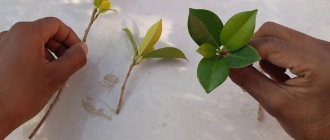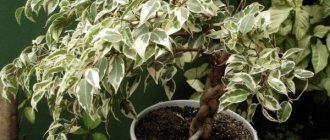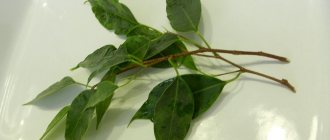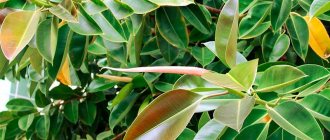- September 11, 2019
- Houseplants
- Alexander Nedashkovsky
Ficus benjamina is very popular among indoor plant lovers. This amazing culture is characterized by incredibly fast growth and speed of leaf growth. It is for this reason that plants are excellent objects for crown formation. Ficus benjamina can be given any shape. But for this you need to have certain knowledge.
Basic Rules
The formation of the crown of Ficus Benjamin is usually carried out in early spring - in March or April. It is believed that this is the best time for the procedure, since before the period of active growth there is still time for the cut sites to heal. After all, during pruning the ficus experiences some stress. To carry out the procedure, you will need garden pruners, activated or charcoal, a disinfectant (potassium permanganate solution or alcohol), and clean wipes. To eliminate the possibility of infection, tools should be treated with potassium permanganate before pruning.
Thick branches are cut at an angle near the bud itself. But thin shoots should be shortened by a third. After trimming the ficus, the cut areas should definitely be treated with a clean napkin to remove the milky juice. After the wound, sprinkle with activated charcoal or charcoal. Cuts on thin branches do not need to be processed, but the sap should still be removed, since it leaves white spots on the foliage. The formation of the crown of Ficus Benjamin is not the only case that requires the removal of branches. Anti-aging pruning is no less important for the plant.
Does ficus need pruning?
Ficus definitely needs pruning to form a crown; this is an important part of care. Without this, you cannot achieve the desired result. It is especially important to pay attention to pruning in the spring. From October to February there is dormancy, during which time the plant is not touched.
Pruning will allow you to form the crown of the desired shape. Best time: end of March - beginning of April. Before active growth begins, the cuttings will heal and the plant will recover.
The roots are also trimmed, especially when they do not fit into the container, intertwining with each other. This spoils the appearance of the ficus and leads to poor nutrition. Only those roots that extend outwards are trimmed.
Sanitary pruning
As we have already said, the formation of the crown of Ficus Benjamin occurs in the spring. But sanitary pruning is carried out at any time of the year. In other words, the procedure is carried out as needed. During pruning, diseased, dry and weak shoots are removed. The branches should be trimmed, as they look completely ugly. They are removed as a safety measure to avoid infecting the entire plant. After all, sometimes dry shoots are a source of disease infection.
If any disease is detected on the ficus, the affected branches are immediately cut off with garden pruners and destroyed. You should not wait until spring to carry out the procedure. Pruning occurs immediately after signs are detected. In addition, weak shoots that do not have a decorative appearance are removed. Such branches make the crown denser, preventing light from entering it.
Anti-aging pruning
This type of pruning is carried out on large Benjamin ficuses, which need to be restored to their former decorative appearance. Sometimes, if there is no watering for a long time, all the branches of the plant dry out. It may seem that the ficus is dead, but it is not. The bush requires anti-aging pruning. It should be carried out before the beginning of the growing season, or rather at the beginning of spring. Dry branches must be completely cut out, and living branches must be shortened by about half. Please note that you need to trim not only the main shoots, but also the secondary branches. The sections are carefully processed.
If the ficus has completely dried out, it can be cut back to a stump. In this case, even the trunk of the Benjamin ficus is almost completely removed. The remaining stump should be no more than 10 cm in height. After such severe pruning, the plant gradually restores its crown, growing new young branches.
The most spectacular varieties of rubber ficus
In total, breeders have developed 12 varieties based on Ficus elastica. Absolutely all cultivars are distinguished by a more demanding attitude towards the environment. Hybrids do not tolerate frequent changes of location and do not tolerate drafts.
There are often cases when, during propagation, a plant completely loses its varietal characteristics. To preserve the appearance, experienced gardeners advise promptly removing leaf blades with a different color from other leaves. We offer photos with descriptions of the most spectacular cultivars.
- Ficus elastica var. Variegata. Like all variegated varieties, it requires good lighting. A lack of light will lead to significant dominance of one of the primary colors. Does not tolerate fungal diseases well. At the first signs of infection, soil replacement and immediate treatment with fungicidal preparations will be required.
- Ficus elastica cv. Black Prince (“Black Prince”). The variety is distinguished by the largest leaves in the genus. The length of the plate can reach 30 cm with a diameter of 18 cm. It acquires its characteristic dark color gradually as it grows. Moreover, the central vein is colored red almost from the first years of life.
- Ficus elastica cv. Sylvie (“Sylvia”). The variegated hybrid differs from F. elastica var. Variegata with wider white border. The cultivar reacts extremely negatively to lack of light and insufficient air humidity.
Types of crowns
Trimming Ficus Benjamin and shaping the crown is a prerequisite for its maintenance. There are several crown options that can be obtained by regular pruning:
- Standard.
- Bush.
- Sculpture.
- Tiered standard.
Most varieties can be used to grow small bonsai trees. How to prune ficus benjamina? It depends on what you want to end up with. The plant is a tall tree. But you can also get a bush from it. To do this, it is necessary to pinch the central trunk of a still young plant. After this, the side branches begin to grow intensively. In just a year you will have a beautiful and lush plant.
Standard forms have a pronounced crown and trunk. Florists distinguish between single and tiered trunks, which have a crown divided into several tiers. Growing such a tree is not easy. This will take three to four years.
Sculptures are created from small-leaved species. Trees are given a pre-conceived shape. Ficus is pruned annually, carefully adjusting its shape.
Ficus plant: how to form a crown and general appearance
Since trimming a ficus so that it is fluffy is not an entirely simple task, you should familiarize yourself with all the rules for forming the crown and improving the overall appearance of the plant:
- branches are partially removed and only those that are poorly positioned;
- the thicker the shoot, the more pronounced the bevel of the cuts should be;
- If you want to get a fairly compact and at the same time voluminous fluffy plant, the top must be pinched periodically. And pinch, not cut. So that later, after trimming, a thick cut trunk does not stick out from above;
- If the plant has suffered a disease and has weakened quite intensively, then it is necessary to radically prune it. The central trunk is shortened significantly, the side branches are also intensively pruned. But it is important to remember that a flower that is too short will simply not be able to recover due to the lack of the proper number of buds and the ability to produce side shoots.
If you need to get the most spectacular tree, you can try to use ficus weaving. True, it will require quite a long time, patience and skills. To implement it, you need to plant several plants at the same time in one large tub. And then, using certain clamps and possibly inserts, begin to weave a frame from the trunks. After the branches become woody, the ficus begins to maintain its given shape.
Ficus: how to form
The standard forms of the ficus plant are very original, but not everyone knows how to form it in this case. The main secret lies in the fact that all side shoots are carefully cut off.
Important ! To make the shape really correct and neat, you need to leave at least 5 side shoots on top. After the plant has been raised to the desired height, its upper part must be constantly trimmed or pinched. In this case, the side shoots will begin to develop more intensively. The result is a spherical crown shape on a thin straight stem.
Bush
How to prune ficus benjamina to make a bush? To form this form of plants, tall and short ficuses are used. Small-leaved species are the most popular because they make very lush bushes. To quickly obtain a bush, several cuttings are planted in a pot, placing them close to each other. As soon as the plant reaches 15 cm after planting, it must be pinched, leaving at least five leaves. This simple solution allows you to stimulate the growth of side shoots.
After the side branches reach a length of 15 cm, their tops are also pinched. Each cut is wiped with napkins, removing juice, and then sprinkled with activated carbon. A dense bush is obtained after the second pruning, when shoots of the third level grow. If the plant is too dense, you can thin out the plant. To grow the bush form, it is very important to organize uniform lighting. To do this, the ficus must be regularly turned in different directions towards the light. Only in this case will the branches grow evenly.
Care after pruning
There are a number of rules that must be followed in order for the flower formation process to be successful:
- When cutting, stumps should not be left, as they become hotbeds for the development of fungal and bacterial diseases.
- After pruning, a milky sap begins to ooze from the plant, which must be immediately wiped off and the cut area sprinkled with crushed charcoal or any fungicide.
- You can fertilize the ficus after pruning once a month.
Ficus pruning process
- In addition, after pruning, it is necessary to regularly wipe the leaves from dust in order to reduce the risk of infection of the plant.
- A month after the procedure, when the cut sites have completely healed and the side parts begin to actively grow, the flower can be replanted, and the top layer of the substrate can be changed for mature plants. Experts recommend using the transshipment method in order to minimize the risk of injury to the root system during transplantation.
Stamb
The standard ficus crown, which has a pronounced trunk, is very popular among gardeners. If you want to grow a standard, you only need to plant one cutting. In the future, all the lower shoots will have to be removed, and only the top 3-4 will remain. To obtain a trunk with a height of 50 cm, the lower part of its trunk without branches should reach 20 cm. Such plants are often called tabletop. How tall does Ficus Benjamin grow if the goal is to get a floor plant? Such specimens can reach one meter. First, the lower part of the plant, the trunk, is grown. And only then they begin to gradually form the crown.
As soon as the height of the ficus reaches the desired value, it is necessary to trim the top shoot by 10 cm. After this, the side branches begin to grow intensively. They must be left only within the crown. If shoots appear on the stem, they must be removed immediately. Subsequently, the crown of the tree is formed in the same way as a bush. When pruning, it is necessary to treat the cuts with charcoal. The standard crown can be made of any shape. The spherical shape is popular, but the oval shape is no less impressive.
Crown formation without pruning
It is better to refuse pruning if it greatly exposes the crown. The procedure is postponed if the plant is sick or pests appear on it. In such cases, the crown can be “made” by hand using stiff wire. Wrap it around the process and point it in the required direction. If the shoots cross each other inside the crown, straighten them by placing a wooden spacer. You can tie branches to the fastenings.
If the crown develops unevenly, grafting will help, that is, transplanting one part of the plant to another. Separate shoots and entire branches are grafted onto Ficus Benjamin. Procedure:
- Cut a shoot or branch from the donor plant at an angle.
- Make a cut in the trunk of another ficus with a sharp tool.
- Insert the cutting into the cut, bandage the transplant site with gauze or plastic wrap.
Artificial growth of the crown and the entire ficus is caused by treating it with growth hormones. This measure will also slow down the aging process. In order for the ficus to actively grow and decorate the house, provide it with all the conditions for development.
Tiered standard
A tiered trunk is a tree whose crown is divided into parts. Between the individual tiers there is a bare trunk without branches. The plant can have two or more tiers. In some cases, they are formed gradually. First, a standard tree with an oval or round crown is created, and then pruning is done in such a way that the central shoot grows. After some time, it will be possible to obtain from it a continuation of the main trunk, and then the next tier of the crown. This process cannot be called fast. But the decorative quality of the finished plant is impressive.
How to shape a ficus benjamina if you want to get a multi-tiered tree? There is also a faster way.
It is much easier to get a tree with several tiers by planting several cuttings and fastening their stems with wire. After some time, they will certainly grow together in the lower part, and the tops of the plants will be separated. Each ficus can be grown as a separate trunk. Their crowns will be at different heights.
By the way, you can plant two seedlings with different foliage colors. In this case, you will get a beautiful tree, the tiers of which have different colors.
Bonsai
How to make a bonsai from ficus benjamina? To obtain such a plant, you can use all varieties of ficus. However, the most suitable variety for this purpose is Viandi, which is characterized by a curved trunk and a low growth rate. It is easiest to get a bonsai from such a sprout.
The technology for growing small dwarf trees from different varieties of ficus is no different. Typically, bonsai are grown in small containers filled with poor soil, causing the plant to grow slowly. The roots of the tree must be trimmed twice a year, after which it is planted again in the same container.
Great importance is attached not only to the formation of roots, but also to branches and trunk. To give the desired shape, the shoots and stem are wrapped with copper wire, which is gradually bent. Such procedures allow you to get a real miniature tree in five years.
Sculpture
According to experts, getting a plant in the form of a sculpture is incredibly difficult, since such work takes a lot of effort and time. Only true masters of their craft can create a ficus in the shape of a bird or animal. It is much easier to get a plant in the form of a cylinder or cone. However, it is worth understanding that even to obtain a simple crown in the form of a geometric figure it will take several years. Every year in the spring it is necessary to prune the plant, removing branches so that the plant has the desired shape.
Ficus weave
Ficus benjamina is beautiful in any form. It's not just plants with a crown that are interesting. Trees grown by ficus weaving can be called a real work of art. Such plants have bare trunks intertwined with each other in a special pattern. Such ficuses are valued because of their beautiful trunks. The crown of plants is usually formed in the form of a ball.
To obtain such a beauty, all varieties of ficus with thin shoots are suitable. But the Viandi variety is absolutely not suitable because it has thick and crooked stems.
To obtain intricacies, several seedlings (their number can be large) of the same size are planted in a pot. Both plants must grow at the same time. The seedlings must be of the same variety, because then they will grow at the same speed. There are various ficus weaving patterns. The simplest ones are the spiral and the braid.
How to braid Ficus Benjamin to get a spiral? To do this, you need to plant two seedlings in a pot. But for the braid you will need three young plants. There are also more complex schemes. Sometimes up to 20 seedlings have to be planted to bring them to life. Only real professionals can grow such trees. To weave trunks, it is necessary to remove side shoots. All weaves should be fixed with copper wire or woolen thread. The shoots are fixed above the plexus. In the future, the ficus is cared for as usual. As soon as the cuttings grow a little, another weaving is done.
The fastening points should be checked every two months. Sometimes they need to be weakened, because during growth the trunks gradually thicken. If the fixation is too strong, it may damage the plant bark. Once the braid or spiral reaches the desired length, you need to fasten the trunk from above. The attachment point will be securely hidden by the crown, so it will not be visible. After a few years, the stems will grow together and turn into a single whole. At this point, all fasteners can be removed. They are no longer needed.
How to form correctly at home?
Pruning and pinching are done for the purpose of rejuvenation. The procedures also allow you to maintain the desired shape and size of the crown so that the tree does not grow, but looks aesthetically pleasing. Pruning is done at a time when the period of active growth begins. This makes it easier for the plant to survive the procedure, and it will recover more quickly.
Important: The culture contains milky juice, which can provoke an allergic reaction, so it is recommended to carry out all manipulations with gloves.
How to braid a tree?
A trunk braided looks beautiful and unusual. To prevent this action from damaging the tree, you need to approach the formation correctly. Many varieties are suitable for growing a bush using this method.
The main condition is that to create a shape you need to take long and thin shoots, preferably young ones.
Two or more cuttings must be planted in one pot. They should be approximately the same size. Otherwise, the cuttings will grow unevenly and you will not get a beautiful plant.
The simplest ways: braid and spiral. Two plants are enough for a spiral. A braid will require three or more.
Pigtail:
- Three cuttings are planted, each height should be about 15 cm.
- When the cuttings begin to grow, weaving begins.
- The lower part should not contain side shoots.
To maintain their shape, the cuttings are fixed. Wire is used for these purposes, but thick thread will also work. Next, the cuttings are cared for in accordance with the requirements of the species. When they grow a little, they make the next weave and fix it again.
How to trim?
A young bush usually does not need additional pruning; it still has few shoots. You can shape an already grown plant.
Ficus benjamina lends itself best to shaping. It has thin shoots, which over time can take on a vertical position due to their own gravity.
The plant can be given a wide variety of shapes:
- form a crown in the form of a ball, diamond or other shape;
- leave as is, only occasionally removing weak and old shoots;
- leave some of the roots on the surface, which will give the plant an even more decorative appearance;
- leave the trunk straight or give it an unusual shape;
- grow a tall tree or make it miniature.
For pruning you will need sharp sterile scissors or pruners. It is better to carry out the procedure in the spring, when the ficus is actively growing. The cut is made above the dormant bud, and activated carbon is sprinkled on top for disinfection.
Growing problems
Very often, during the growing process, flower growers encounter various difficulties. Most often, beginners complain that Benjamin's ficus drops its leaves. There are many reasons for this behavior of plants.
If a bush sheds its leaves in autumn or winter, this is a natural process associated with a dormant period. In this case, there is no need to worry.
Another reason for leaf fall is a change in usual conditions. Houseplants do not respond well to rearrangement, drafts, or lower temperatures. Therefore, the ficus must be kept in its usual conditions.
Excessive cold or heat also affects the foliage of the plant. Temperature conditions and its stability are one of the main conditions of detention. During periods of active growth, ficus needs feeding. The lack of microelements affects the beauty of the crown and decorativeness.
There are many reasons for leaf fall. If you encounter such a problem, you need to find out the reason. And then it needs to be eliminated. After this the situation returns to normal.
Ficus formation
Ficus benjamina has the ability to quickly increase its leaf mass. Therefore, here you can engage in the formation of the plant and the goal of giving it an unusual appearance. To do this, trim the crown and branches at home. As a result of this procedure, a crown of any shape and size can be formed.
Please note that pruning and crown formation for this plant is an integral part of care, without which it is impossible to achieve a beautiful and decorative appearance of the bush. Moreover, to obtain the desired result, pruning at home can be done throughout the year. It is especially important to do this during the growth period. When caring for Benjamin's ficus, you should remember that pruning must be done correctly. During the plant's dormant period, which lasts from October to February, it is better not to touch the bush, especially in terms of shortening it.
To properly form a ficus of this variety, you must remember that its shoots grow from the buds. There are such buds:
- apical. Pinching such a bud during the dormant period will give impetus to the development of lateral shoots. If this procedure is carried out during a period of active growth, then all lateral buds will grow;
- lateral.
The best time for pruning is spring, when active growth is underway and you can get the perfect result. This is also a great time to add fertilizer to the pot.
It is also worth noting that the formation of ficus at home involves pruning not only the crown, but also the root system. Roots can also be trimmed, especially on older plants. Very often, old bushes have roots that climb out of the pot. The roots can even entwine the pot or become entangled with each other. This impairs their nutrition, so such roots should be trimmed. In this situation, the roots should be trimmed, as they spoil the appearance of the plant. But here you should remember that the roots need to be cut in a mirror image in relation to the branches. Typically, roots that are not species are not pruned.
Before answering the question “how to form a ficus Benjamin crown,” you need to know what types of crowns exist for this plant. The crown of this ficus can be shaped in different ways. At the same time, do not forget that the roots, if visible, are formed according to a similar pattern. Today, the crown of Ficus Benjamin can be designed as follows:
- standard Often such a crown is formed in young ficus trees, in which the central shoot is well formed. In this situation, you need to remove the lateral shoots of the 5 upper shoots. And after that, pinching the apical bud. The result should be a bare pillar with a lush crown;
- bush. This crown is formed by pinching the main shoot. This leads to activation of the growth of lateral buds. When they reach a length of 10 cm, they should also be pinned. When forming a dense crown, it is necessary to remove those shoots that grow inside the crown;
- ficus weaving. To create such a crown, you need to plant several shoots in one pot. As they grow, they are woven into spirals or braids. In addition, you can form more complex compositions, such as a wall or fence. But if you are a beginner gardener, then it is better to start with simpler options: braids or spirals.
In addition, you can make crowns of the “tiered standard” type. To get such a crown, you should divide it into 3 parts. The first part is used to create the initial (first) level, and the lateral processes are removed from subsequent levels.
Also, many people prefer to form ficus using the “sculpture” type. This type of crown is used for all small-leaved varieties of ficus. This group also includes Ficus Benjamin. By pinching buds and cutting shoots in different places, you can give the bush the shape of a bird, an animal, or a specific geometric figure. Here you need to calculate everything correctly to make the sculpture more realistic.
For beginners in this business, it is better to form and trim shoots according to simple patterns, leaving more complex options, such as sculpture and fuco weaving, to professionals.
The easiest way to form a ficus of this variety is to give it the shape of a ball. Here, at the age of two years, you should begin to pinch once a month, thereby provoking the growth of lateral branches. The most important thing here is to achieve a uniform and symmetrical crown. As you can see, Ficus Benjamin can be given a wide variety of appearances. But this must be done only in the warm part of the day, and also at the same time as adding fertilizer to the pot.
Instead of an afterword
Ficus benjamina is an amazing plant that is highly valued for its decorative properties. From a simple seedling you can get any crown shape. Most often, people purchase ready-made plants with a formed crown in specialized stores. But you can try to create a beautiful ficus yourself. The plant is suitable for decorating rooms and offices. At home you can get ficus up to two meters high. Such trees look very impressive in any interior. We hope that our article will help you understand all the nuances of crown formation and pruning of Benjamin ficuses.











